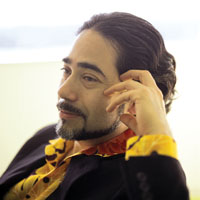Upfront: Letting Creative Lead -- Advertising After the Bubble
Back to Contents of Issue: April 2004
|
|
|
|
by David Kilburn |
|
|
"We creators are like farmers," they said. "Those others are the hunter-gatherers. We should stay apart. That is the natural order of things."
"But you've never tried it," countered Lopez. "Just trust me and see how it works out." The topic was never raised again, and the two tribes became teams that build brands creatively for Procter & Gamble and Philip Morris, among other clients.
This March, Lopez became president of the agency, a job that in Japan usually goes to what are disparagingly called "the suits."
Suits come in many hues: account executives, media buyers and salesmen all supposedly united in a buttoned down approach to the arts and crafts of advertising. In LA, where Lopez grew up, and indeed across the US, there is nothing unusual about a creator leading an agency. The distinction between suits and creatives has little grounding in the reality of an agency thinking about the future.
From the years he spent working in the US, Latin America and Europe Lopez knows that creative ideas are not held hostage by different job titles. Very often they are sparked simply by the little surprises and encounters in everyday interactions between people.
But Japan has its own nuances. "Japan has an island mentality and prides itself on a kind of isolationism. You hear many variations on the notion that 'it is not the Japanese way,' " says Lopez. "However, ideas are ideas and go far beyond cultural barriers. The foundations of ideas at a basic human level, the emotions, the insights are the same, but the colorations and tones that language and culture add to these are dramatically different from one country to another," he explains.
Japan's years of recession have taken their toll on the advertising industry, but Lopez is optimistic. "We are in an upswing," he says. "I first came here during the bubble, when Japanese advertising was fabulous. However, as the bubble burst, agencies seemed to lose their skills. The fragmentation of media, growing reliance on 15-second commercials and famous talent were some of the factors that made for a difficult transition to a recessionary world. On the way, the art was lost.
"Now people are questioning the use of talent, questioning the use of short commercials and finding new ways to engage customers with brands. I am very optimistic. It is time to regain the lost spirit of creativity in advertising."
There is a restless mobility in Lopez's style, a way of speaking that reminds you that here is someone who treasures ideas, looks for inspiration and searches for insight -- all qualities you would look for in an art director, copywriter or filmmaker.
"It is very easy to get lost in this business," he says. "To be sucked into a whirlpool of images, fashion, trends and cliches. But for me, the inspiration is in the little images that pass us every second and simply disappear if we don't open our lives to them." An answer that manages to be opaque, lucid and Japanese all at once. Fans of Tokyo Story and other movies by Yasujiro Ozu will know the creative power generated by ordinary events in daily life, and the insights that come from paying attention to them.
Lopez describes managing a creative team as interacting with people, developing a vision and providing leadership -- the same with managing an agency, he believes. In his new role, there will be more meetings about business plans and fee proposals and fewer about scripts or storyboards.
"But the content of the act is identical," he says. "The content of the act is about people, about having an idea, a vision, a goal."
Therefore, Lopez sees nothing intimidating about his new job. In Beacon's management structure, all the senior people work as a team around a large shared table and are never remote from the detail of one another's work.
As part of this team, Lopez has been closely involved in the business of managing and building the agency since it was created in 2000 by the merger of the Leo Burnett and D'Arcy agencies in Tokyo, with a 34 percent investment by Dentsu. This makes the transition from chief creative officer to president easier to make than it would be in a rigidly compartmentalized agency.
Lopez sees the whole agency as a creative organization. Far from dismantling the creative department a few years ago, he may have actually sowed the seeds of the company as it is today.
"I fundamentally believe Beacon is a creative idea company. I think everyone in the company is creative, whether they went to business school and wear a tie every day or whether they are art directors, copywriters, media people, planners or secretaries.
"Every one of us is a consumer and we are all entitled to have opinions and pass judgment about a brand. No matter what job people may be doing day-to-day, their opinions and experience of brands is completely valid and can add enormous richness to the work we do," Lopez explains.
Harnessing the energies unleashed is the next challenge for Lopez, as both creator and manager in our post-bubble, multimedia world.
@ |
|
Note: The function "email this page" is currently not supported for this page.


 A couple of years ago, when advertising agency Beacon Communications eliminated its creative department, the copy-writers and art directors made a forceful presentation to Alejandro Lopez, their creative director and leader. The idea of dismantling traditional ways of working and obliging creators to work in "Brand Groups" alongside the salesmen and planners filled them with angst.
A couple of years ago, when advertising agency Beacon Communications eliminated its creative department, the copy-writers and art directors made a forceful presentation to Alejandro Lopez, their creative director and leader. The idea of dismantling traditional ways of working and obliging creators to work in "Brand Groups" alongside the salesmen and planners filled them with angst.
 There is more to the challenge than simply regaining past glories. Today, agencies must also think about the Internet, mobile phones, 3G, out-of-home media, in-store activities, events, CRM, database management and all the different ways that people connect to and experience brands.
There is more to the challenge than simply regaining past glories. Today, agencies must also think about the Internet, mobile phones, 3G, out-of-home media, in-store activities, events, CRM, database management and all the different ways that people connect to and experience brands.



